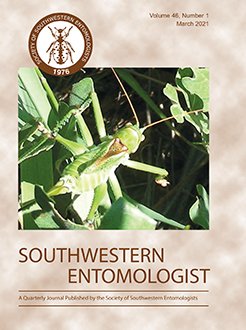Aphid parasitoids on the Southern Great Plains provide important pest suppression services in summer and winter crops. The primary parasitoids Lysiphlebus testaceipes (Cresson), Aphelinus nigritus (Howard), and Diaretiella rapae (McIntosh) use multiple aphid host species on multiple crops in agricultural landscapes and historically, L. testaceipes has been the most abundant and arguably most important. However, after the sugarcane aphid, Melanaphis sacchari (Zehntner), infested sorghum (Sorghum bicolor (L.) Moench) on the Southern Plains, A. nigritus increased in abundance and impact on this summer crop. We hypothesized that A. nigritus also would be more abundant in fields of winter wheat (Triticum aestivum L.) and winter canola (Brassica napus L.) in the region following the sugarcane aphid. From 2016-2019, we documented aphid parasitoid abundance and percentage of parasitism in Oklahoma winter crops during late fall and early spring using a standardized sentinel aphid deployment retrieval and rearing approach. Unexpectedly, A. nigritus was relatively abundant during Fall 2016, parasitizing as many as 5.4% of sentinel aphids in winter wheat fields which was more than the typically dominant parasitoid L. testaceipes. However, percentage of parasitism by A. nigritus decreased during the study. Our results suggested that abundance of A. nigritus mirrored those of sugarcane aphids in the region, and the temporary presence of the parasitoid in winter crops reflected dynamics at a landscape level.
How to translate text using browser tools
25 March 2021
Increase in Importance of Aphelinus nigritus (Howard) on Winter Crops in Oklahoma Coincides with Invasion of Sugarcane Aphid on Sorghum in Oklahoma
K. L. Giles,
N. C. Elliott,
H. E. Butler,
K. A. Baum,
G. F. Backoulou
ACCESS THE FULL ARTICLE

Southwestern Entomologist
Vol. 46 • No. 1
March 2021
Vol. 46 • No. 1
March 2021




